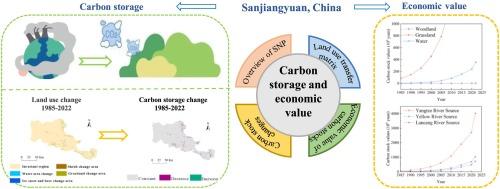Estimation of carbon stock and economic value of Sanjiangyuan National Park, China
IF 7
2区 环境科学与生态学
Q1 ENVIRONMENTAL SCIENCES
引用次数: 0
Abstract
Sanjiangyuan National Park (SNP) is one of China’s national parks with high ecological significance and ecological vulnerability. In order to promote the healthy development of national park ecosystems, it is extremely important to investigate the carbon sequestration potential and the economic value of carbon sequestration in the SNP. Here, we comprehensively analyzed the characteristics of land use change from 1985 to 2022 based on the land use transfer matrix and land use dynamic degree, calculated the ecosystem carbon storage based on the InVEST model, and estimated the economic value of carbon storage in each period combined with compound interest present value method. The results show that: (1) From 1985 to 2022, carbon stocks generally went through three phases: increasing, stabilizing, and decreasing. (2) Low carbon density areas were concentrated in the Kekexili Natural Reserve in the Yangtze River Source Park and a small part of the Yellow River Source Park and Lancang River Source Park; The high carbon density area was concentrated in the water area and the forest land in the southeast of the Lancang River Source Park. (3) Land use change in SNP had a decisive impact on carbon storage change, and the economic value of carbon storage in SNP continued to increase from 1985 to 2022. In order to provide a scientific basis for the sustainable management of carbon sinks and the reduction of carbon emissions in the SNP area, it is necessary to further study the carbon cycle process, carbon storage and carbon emissions in the region in the future.

中国三江源国家公园碳储量与经济价值估算
三江源国家公园(SNP)是中国生态意义重大、生态脆弱的国家公园之一。为了促进国家公园生态系统的健康发展,研究三江源国家公园的固碳潜力和固碳经济价值具有极其重要的意义。在此,我们基于土地利用转移矩阵和土地利用动态程度,综合分析了1985-2022年土地利用变化特征,基于InVEST模型计算了生态系统碳储量,并结合复利现值法估算了各期碳储量的经济价值。结果表明(1)从 1985 年到 2022 年,碳储量总体上经历了增加、稳定和减少三个阶段。(2)低碳密度区主要集中在长江源公园的柯柯溪里自然保护区、黄河源公园和澜沧江源公园的一小部分区域;高碳密度区主要集中在澜沧江源公园东南部的水域和林地。(3)澜沧江源园区土地利用变化对碳储量变化具有决定性影响,1985-2022 年澜沧江源园区碳储量经济价值持续增长。为了给思南县碳汇的可持续管理和碳减排提供科学依据,未来有必要对该地区的碳循环过程、碳储存和碳排放进行进一步研究。
本文章由计算机程序翻译,如有差异,请以英文原文为准。
求助全文
约1分钟内获得全文
求助全文
来源期刊

Ecological Indicators
环境科学-环境科学
CiteScore
11.80
自引率
8.70%
发文量
1163
审稿时长
78 days
期刊介绍:
The ultimate aim of Ecological Indicators is to integrate the monitoring and assessment of ecological and environmental indicators with management practices. The journal provides a forum for the discussion of the applied scientific development and review of traditional indicator approaches as well as for theoretical, modelling and quantitative applications such as index development. Research into the following areas will be published.
• All aspects of ecological and environmental indicators and indices.
• New indicators, and new approaches and methods for indicator development, testing and use.
• Development and modelling of indices, e.g. application of indicator suites across multiple scales and resources.
• Analysis and research of resource, system- and scale-specific indicators.
• Methods for integration of social and other valuation metrics for the production of scientifically rigorous and politically-relevant assessments using indicator-based monitoring and assessment programs.
• How research indicators can be transformed into direct application for management purposes.
• Broader assessment objectives and methods, e.g. biodiversity, biological integrity, and sustainability, through the use of indicators.
• Resource-specific indicators such as landscape, agroecosystems, forests, wetlands, etc.
 求助内容:
求助内容: 应助结果提醒方式:
应助结果提醒方式:


